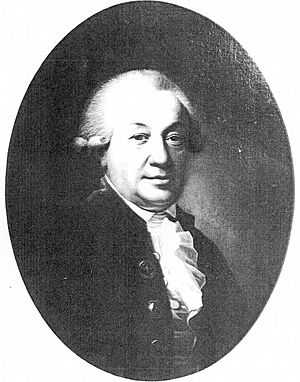Peter Pierre Tutein facts for kids
Quick facts for kids
Friederich Tutein
|
|
|---|---|
 |
|
| Born | 11 October 1726 |
| Died | 7 December 1799 (aged 73) Copenhagen, Denmark
|
| Nationality | Danish |
| Occupation | Merchant and industrialist |
Peter Pierre Tutein (born October 11, 1726 – died December 7, 1799) was a successful German-Danish businessman. He was a merchant, meaning he bought and sold goods, and an industrialist, meaning he owned factories. In 1747, he started a very successful trading business in Copenhagen, Denmark. He used his own ships to trade with Danish colonies far away. His business was so big that his son, Friederich Tutein, took it over after Peter's death.
Contents
Peter Tutein's Early Life and Training
Peter Tutein was born in Mannheim, a city in what was then called the Holy Roman Empire. His parents were Pierre Tutein and Elisabeth Henri. When he was young, he trained to become a merchant in a town called Landau. This training taught him how to buy, sell, and trade goods.
Building a Business Empire
Starting in Copenhagen
Tutein moved to Copenhagen, the capital of Denmark, in 1748. He first managed a trading company for someone else. But in 1756, he decided to start his very own trading business.
Trading Across the Seas
His company quickly became one of the most successful in Copenhagen. He traded with Danish colonies, which were lands far away controlled by Denmark. He even had his own fleet of ships to carry goods across the oceans.
Tutein had strong connections with the Danish Asiatic Company. This was a big company that traded with places like India and China. Some of his ships were also involved in the "triangular trade." This was a trade route that connected Europe, Africa, and the Americas.
Peter Tutein mainly traded in "colonial goods." These were products that came from the colonies. He imported a lot of coffee and sugar. In fact, he was one of the biggest coffee importers in Denmark during his time!
Venturing into Factories
Besides trading, Tutein also invested in factories. He became the owner of a factory that made stockings after he got married. He also became a partner in a factory that made calico fabric. This factory was first in Klampenborg and later moved to Østerbro.
In 1779, Tutein planned to open a factory that made silk ribbons. He got permission to build it in Nørrebro. However, he later changed his mind and sold the land to the government.
A Leading Businessman
From 1769, Tutein was a member of a group called Grosserer-Societetet. This was an organization for important wholesalers, or big merchants. By the late 1780s, his company was the third largest trading business in Copenhagen. Only two other companies were bigger than his.
Peter Tutein's Family Life
On May 12, 1756, Peter Tutein married Pauline Marie Rath at St. Peter's Church. Pauline had been married before, but her first husband had passed away.
Peter Tutein lived in a city home at Købmagergade 13 in Copenhagen. He also owned a beautiful country house called Sneglebakken in Lyngby starting in 1783.
Peter Tutein passed away on December 7, 1799. He was first buried in Assistens Cemetery. Later, his remains were moved to Hvedstrup Church.
Peter and Pauline had one son and three daughters who lived to be adults. Two other daughters died when they were babies. His son, Friederich Tutein, took over the family's trading business. He renamed it Fr. Tutein & Co. His daughters also married into important families.


